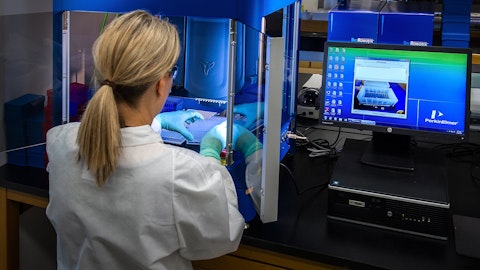Unidentified Analyst: Great. Thank you.
Operator: Thank you. One moment for our next question. Our next question comes from the line of Brian Skorney from Baird.
Brian Skorney: Hey, good afternoon. Thank you for taking the question. First, quick one, you previously given the weights at dosing of the other patients, just wondering if you could provide the weight of patient number five here and not jumping out to me based on the data provided so far, that there’s differentiation between dose level one and two and western or CK level changes. So I’m just wondering what’s kind of informing the decision to go at dose level two? Thanks.
Ken Mills: Yes, Brian, again, I mean, I think we’re looking at a data set in dose level two right now that is entirely based in eight and above. And the dose level one data includes one patient from that age range, but the two other patients that are in the four to seven range, which I know to all of you and to most people, is a more familiar territory because that’s what the data is that has been shared most often and almost entirely with respect to existing labeling of the accelerated approved product, as well as data from other data sets from other programs. For us, look, I think there’s several things. We are seeing ranges of results here that are consistent with what we’ve observed in animal models, where we’ve seen differentiation of those doses in terms of functional outcomes in the animals.
The other thing is that we’re looking at the range of the results overall, and we’re incredibly happy and proud of the fact that everything that we’re seeing and reporting is already in double digit microdystrophin ranges, not the case with other data sets as you look at them. So achieving that, I think, says something to us about the overall stability and the overall quality of RGX-202 as a candidate as design. But secondarily, I think we do see RGX-202 at DL2 again having something that is just between those two results, close to 50% microdystrophin expression. And these are in boys one who’s 12 and one who’s eight. And for us, those are the types of boys that are more progressed disease with, frankly, that are more challenged to be able to get levels of microdystrophin expression with gene therapy.
And I think that’s reflective of the evidence that other programs haven’t even chosen to progress or share data in those types of age ranges. So this is what has got us incredibly enthused and excited is that dose level one showed us, yes, we can get great results in four to seven year olds and we got a strong result also in an older boy, a 10-year-old in that case. But in dose level two, the first two kids that we enrolled were older boys and we got what we think are phenomenal results. That and the safety profile was an easy decision, along with discussions we’ve been having with FDA to designate that as our pivotal dose.
Brian Skorney: Great. And just how about the weight for patient number five? Do you have that?
Ken Mills: Yes. Sorry, I didn’t hear you. Did you say weight?
Brian Skorney: Yes, yes. Can you tell us the weight of patient number five? I think you provided the other weights.
Ken Mills: Oh, yes. I don’t have that off the top of my head. I’ll have to follow up with you on that.
Brian Skorney: Thanks.
Operator: Thank you. One moment for our next question. Our next question comes from the line of Danielle Brill with Raymond James.
Unidentified Analyst: Hey, guys. This is Alex on for Danielle. Thanks for the question. A couple on 314. Given the updates today, do you still plan to publicly disclose data updates from ALTITUDE later this year? And just curious, why the large gap between now and the guided end of Phase 2 meeting with FDA in 1Q 2025. And then looking at wet AMD, to us we think the wet AMD is a dataset a little bit more mature. So we would have guessed that that would have been advanced or pivotal as well. So what kind of data or time points do you and AbbVie need to see to convince you to advance the suprachoroidal wet AMD forward to pivotal development? Thanks.
Ken Mills: Yes. Thanks, Alex. You’ve hit on an important point. We’re working in partnership with AbbVie here to ensure a successful program, including significant commercial and clinical value, is achieved. We’re well aligned with them on this guidance and we’ve been focused on the fact that when we bring a package forward to the FDA for pivotal design, which would be the first such pivotal package for suprachoroidal delivery, for gene therapy in diabetic retinopathy that it’s going to be as robust and sort of important as you could expect for that conversation. And we don’t rule out that things could be done on an accelerated basis to beat that guidance. But right now we sort of felt most confident in the Q1 2025 guidance, which is months away, right.
And so for us, also the fact that we view initiation of the pivotal in the first half of 2025, I think, can sort of emphasize that. We think that the sort of time, energy and effort that would be put into an end of Phase 2 discussion will be something that we can accelerate off of in terms of pivotal initiation overall. With respect to suprachoroidal device overall and program plans between diabetic retinopathy and wet AMD. This is actually pretty consistent and predicted for us. We talked about back in the end of 2023 that the diabetic retinopathy data that was presented was maturing and kind of coming into focus in terms of key measures of efficacy and safety. That was a little bit ahead of where we saw things with respect to wet AMD suprachoroidal.
We updated wet AMD suprachoroidal in the Hawaiian Eye Meeting earlier in the year at six month data and said we were encouraged by that, but also viewed that it was – the decision was potentially frame shifted from diabetic retinopathy by at least a few months, and so we continue to maintain and sort of guide that overall. What I would say is, eventually one of the indications has to be the first to go into pivotal phase and into that discussion with FDA. I think that, the view that the first also would be the one that would be a two pivotal trial design approach is something that I think is consideration overall and that we feel strongly, I know at REGENXBIO and in alignment with AbbVie about this that the unique nature of the data that we’re seeing in diabetic retinopathy and the unique unmet need is also something that is very attractive for bringing that forward as the potential first application of the suprachoroidal delivery approach.
But we have guidance for Q3 update on wet AMD as well, and we’ll be able to talk more about that program then.
Unidentified Analyst: Great. Thanks so much.
Operator: Thank you. One moment for our next question. Our next question comes from the line of Mani Foroohar from Leerink.
Unidentified Analyst: Hi, this is Lily on for Mani. Thank you for taking a question. So maybe just a quick follow up in terms of the suprachoroidal for 314. So in terms of the data updates, can you maybe just give us a little bit more granularity in terms of, so we’ve seen six months, the follow up timing that we would be seeing and also the potential data point that would basically influence your decision? Thank you.
Ken Mills: Sure. I don’t think we have any more specific guidance right now on what the next data updates are going to include. Again, our process here working in partnership with AbbVie, is right now we’re focused on program execution and acceleration based on these positive interim results that we’ve decided for diabetic retinopathy led us to this updated guidance on initiation of the pivotal. But we generally have kept a reasonably steady cadence of updating the community at conferences, and when we’re able to bring additional data forward, usually in settings of medical conferences, we do. Right now, we expect the next program update in data for wet AMD suprachoroidal to be in Q3, but we’re especially excited that the diabetic retinopathy program now has guidance for the first suprachoroidal program to move into pivotal phase.
Operator: Thank you. [Operator Instructions] Our next question comes from the line of Luca Issi from RBC Capital.
Luca Issi: Great. Thanks so much for taking my question. Congrats on the progress. Maybe a quick one on DMD, circling back on the pre-existing immunology, you’re obviously trying to differentiate DMD in multiple ways including the C-Terminus domain, as well as obviously going after broader patient’s population. But what percentage of patients will be eligible for your therapy simply because they have neutralizing antibody against both Sarepta and Pfizer? Just trying to get a numerical percentage here on the kind of lowest hanging food? And then maybe on the competitive landscape for the ocular gene therapy, we recently saw some data for the long acting TKI, data was somewhat mixed for DR despite actually pretty good data for wet DMD. What are your thoughts on what drives that dichotomy between the two? And maybe more broadly, what are your thoughts on long acting TKI as a potential competitive threat for your program? Thanks so much.
Ken Mills: Yes. Thanks. Luca. So I think you do a pretty solid job at modeling the concept of the cross reactivity of different serotypes. Luca, I think we generally have offered up that 202 may be a solution on its own. Again, that’s with two other competitive products. Let’s say Sarepta and Pfizer are competitive with a REGENX product in a hypothetical medical firm, where you’d be looking at cross reactivity of the different AAVs and say what’s left uniquely for REGENX. I think that’s about 15%. I think you can draw on that from a number of sources of data. Again, it’s generally accepted and known that the prevalence of neutralizing antibodies against any AAV capsid is going to be something on the order of 30%, maybe even 40% of subjects, I mean, even more for some of the earlier AAVs, like AAV2 for instance, but in general, where we are with an rh74, AAV9 or REGENX’s AAV8.
So I think in the case where there’s two competing products, 15% in the case when we’re second to market, which I think is a possibility we need to start considering here for RGX-202 in terms of where we are positioned to continue to execute the safety profile, the data that we’re showing can be above that number. I could see 20% to 30% in a head-to-head comparison with another vector. On the comment about TKI, I mean, good observation. I know there was a couple of data sets that have been presented in the last few months, both in NPDR, I mean, obviously like AAV gene therapy, RGX-314 the body of evidence around the clinical data between subretinal and suprachoroidal, and its ability in a continuous way with its [indiscernible] profile to target anti-VEGF or VEGF with basically a molecule that’s a known approved therapeutic entity.


